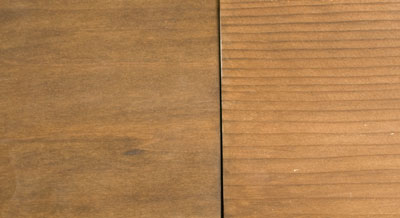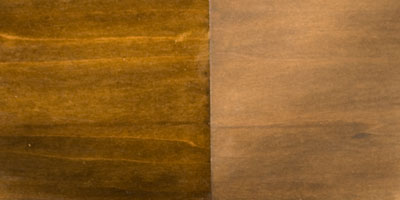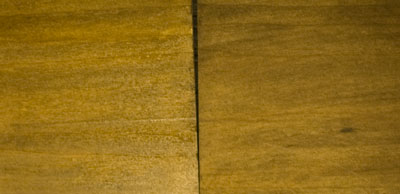|
|
01/18/2010 |
I don't know. Really, I don't. I get asked this question at least three times a week and for someone like me who pretends to know everything it's really frustrating to tell people that I don't have a clue.
I don't. Here's why:
How the color of the dye is perceived works is a function of the color of the dye, the strength (dilution) of the dye, the underlying color of the wood underneath it, the texture of the wood and how the sheen of the wood reflects light, the color of the topcoat over the dye, the lighting on the piece, and the color of the piece next to the dyed piece. I might have left out a few criteria but that's the gist of it. Look at the following examples: | All the examples use the same walnut dye at the same strength. Of course you can vary the strength of the dye and the intensity of the color just by diluting the dye.
|
Same dye, same strength, on two different types of bare wood (poplar and pine)

|
Same dye, Same strength, on poplar. Top coated with blond shellac on the left, no topcoat on the right.

|
The previous samples were photographed under natural sunlight near a window. This picture is of the same wood but under regular fluorescent lighting.

|
Here is a walnut stain sample surrounded by a dark or light border.
|
Do you see what I mean.
|
In part two (which may or may not be the next blog entry) I'll talk about things I discuss when in spite of my ignorance I try to help people get the
color dye they want.
Note: Due to the way I like to photograph things the pictures are redder than they are in real life.
|
|
Join the conversation |
|
 Joel's Blog
Joel's Blog Built-It Blog
Built-It Blog Video Roundup
Video Roundup Classes & Events
Classes & Events Work Magazine
Work Magazine





loved this post and appreciate the honesty! When I work with clients on a custom piece of furniture the fist thing I tell them is that I don't use stain- if they want a dark tone, then I recommend a dark wood. If it's a lighter shade they're after then I suggest a lighter species. I never understood why people work with say, birch and then go through all of the trouble to make it look like cherry or walnut.
I laugh when I walk through the big box stores and see examples of a 'cherry finish'...it's usually a dark, puple/red tone that ressembles a plactic rose wood or something.?
I do appreciate dye's and stains when used as an aesthetic compliment or in a detail for accentuating something visually- perhaps an inlay or a moulding....but working with one species for an entire project and then staining it to look like an altogether different species is something that always left me scratching my head.? But hey, that's just my two cents.
Thanks for the great blog and keep well.
Tom